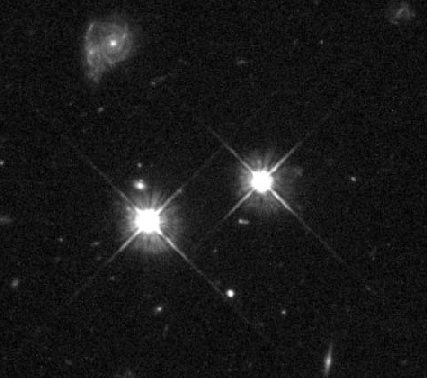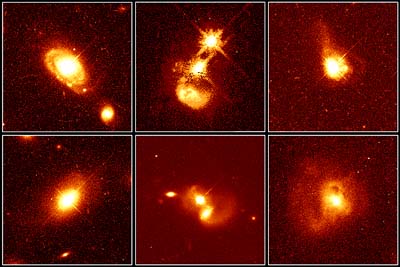
[Image credit: C. Steidel (Caltech) & NASA]
In the image below, taken using the Hubble Space Telescope,
the bright blob on the left (surrounded by four diffraction
spikes) is a quasar; the bright blob on the right is a star.
See any difference? Not really - quasars and stars are both unresolved
sources of light. To distinguish between them, we need a spectrum.

[Image credit: C. Steidel (Caltech) & NASA]
Spectra of quasars taken at visible wavelengths revealed that they had truly bizarre emission lines -- the wavelengths of the lines didn't correspond to any known atom, ion, or molecule. Astronomers were baffled.
The bafflement was ended by the astronomer Maarten Schmidt in 1963. Schmidt discovered that the brightest emission lines in the spectra of quasars corresponded to the emission lines of ordinary atomic hydrogen, but that they were extremely redshifted. For instance, the quasar named 3C 273 (the quasar with the greatest apparent brightness as seen from Earth) has a redshift of z = 0.158. Most quasars have even larger redshifts. The record for ``highest redshift quasar'' has been frequently broken in recent years. At the time I wrote these notes, the record was held by a quasar with a redshift z=6.4. At such high redshifts, the simple formula v = cz no longer applies. A redshift greater than one doesn't imply that the quasar is moving away faster than the speed of light. (For the curious, the relativistic formula for converting redshift to radial velocity is given in box 27-1 of the textbook.)
The redshift of 3C 273 implies that it is moving away from us with a speed v = 44,000 km/sec. Its distance, from the Hubble law, is d = v/H0 = 620 Mpc (about 2 billion light-years, or about 1000 times the distance to the Andromeda Galaxy).
There's a favorite saying among astronomers:
``A telescope is a time machine.''
It's a one-way time machine, however, which only
let's us look into the past, not into the future.
Because light travels at a finite speed, when you
look at any object, you see it as it was in the
past. When you look at the Sun, for instance,
8.3 light-minutes away, you see it as it was
8.3 minutes ago. (For that matter, when you
look at your computer screen, you see it as it
was one or two billionths of a second ago.)
Because quasars are very far away, we see them
as they were a very long time ago.
The closest quasars are at a distance of
1 billion light-years. Thus, we see them
as they were 1 billion years ago. The most
distant quasars are at a distance of 13 billion
light-years. Thus, we see them as they were
13 billion years ago, when the universe was young.
The Age of Quasars, it seems, is over. Surveys of the sky, searching for quasars, reveal that the highest density of quasars is at a distance of roughly 11 billion light-years, indicating that quasars were most prevalent in the universe 11 billion years ago. Between 9 and 13 billion years ago, there were plenty of quasars in the universe. More recently, however, there have been very few.
Quasars have luminosities which lie in the range L = 10 to 100,000 LMW, where LMW is the luminosity of the Milky Way galaxy, which in turn is 25 billion times the luminosity of the Sun. Thus, even the dimmest of the quasars is far brighter than a big galaxy like our own.
The luminosity of quasars can vary significantly on timescales of only a week. Thus, the bulk of the immense luminosity of a quasar must be coming from a region only one light-week (1200 A.U.) across!
An important clue is given by photographs (or the electronic equivalent) of quasars. In a short exposure, only an unresolved ``quasistellar'' point of light is seen. However, in a longer exposure, the point is surrounded by ``quasar fuzz'' - an extended luminous area. The quasar fuzz is actually the starlight from a galaxy surrounding the quasar. Thus, we conclude that quasars are the *extraordinarily* bright nuclei of galaxies.
The six images below are pictures of six quasars taken by
the Hubble Space Telescope, clearly revealing that the
``quasar fuzz'' surrounding the central bright nucleus
is actually a galaxy. Note that some of the galaxies
are undergoing mergers and are obviously disturbed.

[Image credit: John Bahcall (IAS), Mike Disney (University of Wales) & NASA]
So, let's synthesize some of our knowledge into a plausible hypothesis:
The brightest quasars must consume gas at a rapid rate to maintain their luminosity. The brightest quasars have a luminosity of L = 100,000 LMW = 1042 watts. If the mass of the swallowed gas is converted to energy with perfect efficiency, the amount of gas need to produce 1042 joules of energy is M = E/c2 = 1025 kilograms. Thus, every second, the quasar must consume at least 1025 kilograms of mass - that's twice the mass of the Earth! Every year, it must consume at least 200 times the mass of the Sun. (And since quasars don't work with perfect efficiency - nothing's perfect, after all - the amount of matter consumed will probably have to be much greater than 200 solar masses per year.) Obviously, the quasars can't keep it up for long. A black hole which grows in mass by 200 Msun per year will grow to a mass of over two trillion solar masses during the age of the universe. This is larger than the mass of an entire galaxy! Bright quasars, we conclude, must be a temporary stage of a galaxy's existence.
The question remains: ``Where have all the quasars gone?'' After all, the supermassive black holes that powered the quasars are still around (and more massive than ever, thanks to the gas that they've accreted). However, gas is being fed into them at a much lower rate than was true in the past. Eleven billion years ago, galaxies interacted more frequently than they do at present. During mergers and close encounters between galaxies, tidal forces increase the rate at which gas is fed into the central black holes. Currently, gas is being accreted by black holes at a much lower rate, resulting in galactic nuclei which are much lower in luminosity than they were in the past.
Old quasars never die; they only fade away.
Updated: 2003 Feb 27
Copyright © 2003, Barbara Ryden